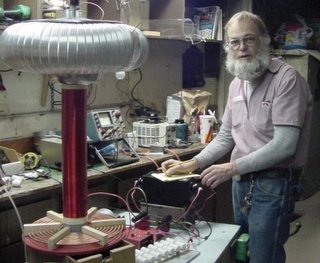
It's off topic a bit, but reading about the Tookie Williams execution inspired me to bring out an article I wrote last year for THE RAKE, about the weird history of capital punishment and the bizarre Garry Commission.
1000 Dead Men
William Gurstelle 2004 - all rights reserved
Sometime in the middle of this year, the 1000th man condemned to death since the reinstatement of capital punishment in the U.S. will walk from a holding cell to a starkly lit, barren execution chamber. There, a team of guards and technicians will operate the state’s machinery of human destruction, carefully designed to bring about the quick and efficient death of the prisoner.
Like most of the previous 999 executions, this one won’t have much in the way of uncertainty or technical novelty. It will private, clinical, and most likely, pain-free. For that small favor, Condemned Man Number 1000 can thank an obscure New York bureaucrat named Elbridge Gerry.
In the late 19th Century, after a number of botched executions by hanging, that resulted in slow strangulation and/or decapitation, the State of New York began searching for a more humane method of capital punishment.
New York’s governor appointed a committee of experts to evaluate alternatives to hanging for convicted and condemned capital murderers. This committee became known as the “Gerry Commission,” after its chairman, Elbridge Gerry.
Under Chairman Gerry’s watch, 31 deadly ideas were brainstormed and described in the Commission’s March 1888 report to the governor.
In all likelihood, the Gerry Report is the most bizarre and grotesque report ever produced by a committee of government bureaucrats. For weeks, the plucky public servants brainstormed, researched and categorized all the ways of killing people they could think of. Then, they comprehensively, deliberately, and dispassionately examined the merits of each in alphabetical order.
In discharging their obligation, they duly considered and evaluated 31 possible methods of carrying out the sentence of death, many apparently dredged up the most hidden and ghoulish recesses of a bureaucrat’s sadistic soul. In the end, they came up with a list. Some of the more unusual suggestions included:
Beating to death with clubs
Beheading
Blowing from a cannon (The commission became interested in this method of execution based on reports of its use in the East Indian army in the 19th Century. The commission notes two ways for carrying out this sentence. First, “the insurgent is lashed to the cannon’s mouth. Within two seconds of pulling the trigger, he is blown to 10,000 atoms.” Alternatively, “the living body of the offender is thrust into the cannon, forming, as one might say, part of the charge.”)
Boiling (“usually in hot water but sometimes in melted sulfur, lead or the like”)
Burying alive
Crucifixion
Dichotomy (cutting a person in half)
Dismemberment (like dichotomy but even messier)
Drowning
Exposure to wild beasts (In due diligence, the commission briefly considered the method of execution served on female criminals in Tonquin, (present day Vietnam). The commission noted the condemned were “tied to a stake and in that situation delivered to an elephant who seizes them with his trunk, throws them into the air, catches them on his tusks, and finishes them off by trampling.”)
Lapidation (to cause death by throwing stones)
Peine forte et dure (placing heavy weights to stop breathing)
Pounding in a mortar. In Proverbs 27:22, the Bible reads, “Though thou shouldest bray a fool in a mortar among wheat with a pestle, yet will not his foolishness depart from him.” This biblical passage prompted a religious Gerry commission member to consider “pounding in mortar” as a possible method of serving the death sentence. Presumably, this procedure would involve the condemned being placed in a large mortar or similar vessel and then pounded with an enormous pestle. This is much the preparation of a mint julep, except a condemned prisoner is substituted for mint leaves.)
Precipitation (throwing from a cliff)
Garroting
Running the gauntlet
Stabbing
Strangling
Use a little imagination, and you can envision the tenor of the debates swirling around the conference table of the Gerry Commission. On one side of the table might have been the dismemberment and stomping elephant advocates, sniping derisively at the beheading and garrote crowd about their relative daintiness, while the ‘blowing from a cannon’ promoters crowed about the sure-fire nature of their choice, as well as the state’s ability to raise funds by charging admission.
While some of these methods (e.g. boiling, crucifixion, and throwing from a cliff) may have possessed an impressive deterrent effect, few of them fit the commission’s objectives of speediness, humaneness, and efficiency in execution.
Brainstorming session over, the work of winnowing out the cruel, the unworkable, and the just plain weird ideas began. In the end, no ideas remained –- all were considered either too cruel or weird.
“Your Commission have examined with care the accounts which exist of the various curious modes of capital punishment. . . that have been used. The result (is that none of these) can be considered as embodying suggestions of improvement over that now in use in this State.”
The felons on New York’s death row, may (or may not) have sighed in relief, knowing that the whole mortar and pestle thing was off the table.
One 116 years later, Condemned Man Number 1000 will lie on the gurney as orderlies attach long tubes to the needle inserted in his arm. When the lethal drip starts, he may take a bit of comfort in knowing it could have been worse.
# # #

























